Yesterday, July 30, Newsweek highlighted North Carolina, South Carolina, and Washington as states that “have seen some of the largest spikes in coronavirus cases.” NPR noted that “the state saw a spike in newly confirmed cases of the coronavirus.”
What’s going on? Here’s a reminder:
It’s important to know that what media report as “cases” are not the same as infections.
An infection is any time someone has the virus, whether that person feels sick or not. A case is when an infection has been confirmed by testing. For sake of clarity, I have been using the term known cases.
So what’s going on is this: the spike North Carolina is seeing is in testing bringing about a proportionate spike in known cases. A greater proportion of the unknown number of active infections out there are becoming known cases.
This is a good thing except when media and public confusion over “cases” is used disingenuously by Gov. Roy Cooper and DHHS Sec. Mandy Cohen to justify business shutdowns, half-shutdowns, greater personal restrictions, and K-12 schools forced online.
From the graph above, you can see the dramatic increase (if you’re so inclined, call it a spike or a surge) in COVID-19 testing over the past four months:
April
• 104,930 tests (8.6% positive; 9,011 new known cases)
May
• Huge jump in testing (over 2.7 times more tests than in April)
• 288,253 tests (6.3% positive; 18,080 new known cases)
June
• Another big jump in testing (over 1.7 times more tests than in May)
• 493,744 tests (7.3% positive; 36,081 new known cases)
July
• Another big jump in testing (over 1.7 times more tests than in June)
• 847,069 tests (6.8% positive; 57,478 new known cases)
The proportion of tests returning positive continues to stay relatively flat (it has declined some over the month of July):

“Cases” vs. “Active cases”
Also, as I discussed earlier this week,
More testing helps us find more known cases of infections, many of which include asymptomatic people or people who don’t feel unwell. Active cases are known cases minus deaths and recoveries.
Here’s a chart showing active cases, which fell last week for the first time, and recoveries and deaths:

Click here for more information about that graph.


